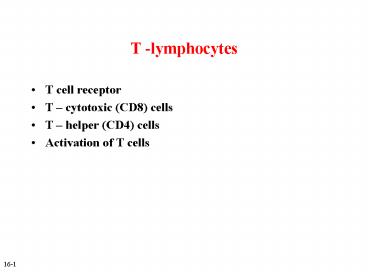T -lymphocytes - PowerPoint PPT Presentation
Title:
T -lymphocytes
Description:
T -lymphocytes T cell receptor T cytotoxic (CD8) cells T helper (CD4) cells Activation of T cells T cell receptor Alpha and beta polypeptide chains Antigen ... – PowerPoint PPT presentation
Number of Views:136
Avg rating:3.0/5.0
Title: T -lymphocytes
1
T -lymphocytes
- T cell receptor
- T cytotoxic (CD8) cells
- T helper (CD4) cells
- Activation of T cells
2
T cell receptor
- Alpha and beta polypeptide chains
- Antigen - major histocompatibility (MHC) binding
site
3
Figure 16.15 two different T cell receptors
4
Figure 16.16 MHC molecules
5
Figure 16.17 Antigen recognition by T cells
6
T cytotoxic cells
- Induce apoptosis
- Produce cytokines
- Recognize MHC class I molecules and endogenous
antigen
7
Figure 16.18 T-cytotoxic cells
8
T helper cells
- Recognize MHC class II and exogenous antigen
- Ex. Th1 cells recognize antigens bound to MHC II
molecules on macrophages - Ex. Th2 cells recognize antigens bound to MHC II
molecules on B cells
9
Figure 16.19 T-helper cells
10
Figure 16.9 B cell, T cell interactions
11
Activation of T cells
- Dendritic cells
- Activated macrophages
12
Figure 16.20 Activation of T cells
13
Natural Killer (NK) cells
- Antibody dependent cellular cytotoxicity (ADCC)
- Kill cells that do not have the MHC class
molecules
14
Figure 16.6 Protective outcomes of Ab-Ag binding
15
Lymphocyte development
- Generation of diversity
- Negative selection of self reactive B and T
cells
16
Diversity created by Gene rearrangements
Imprecise joining Combinatorial associations
Figure 16.22 Antibody diversity
17
Negative selection
- Eliminate B cells that recognize self molecules
- (ie, clonal deletion failure creates
autoantibodies) - B cells do not respond (no specific T cell
interaction) - Eliminate T cells that do not recognize MHC
(positive selection) - Eliminate T cells that bind to self peptides
presented by MHC molecules (negative selection)
18
Figure 16.21 Summary of the immune system

